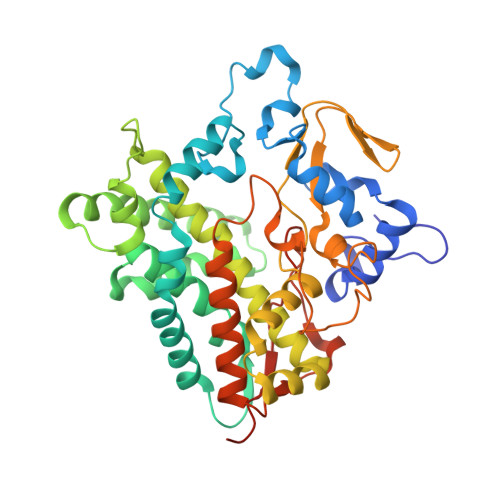Structural insights into the mechanism of the drastic changes in enzymatic activity of the cytochrome P450 vitamin D3 hydroxylase (CYP107BR1) caused by a mutation distant from the active site
Yasutake, Y., Kameda, T., Tamura, T.(2017) Acta Crystallogr F Struct Biol Commun 73: 266-275
- PubMed: 28471358
- DOI: https://doi.org/10.1107/S2053230X17004782
- Primary Citation of Related Structures:
5GNL, 5GNM - PubMed Abstract:
Cytochromes P450 (P450s) are haem-containing enzymes that catalyze medically and industrially important oxidative reactions, and many P450s have been subjected to directed evolution and site-directed mutagenesis to improve their activity and substrate specificity. Nonetheless, in most cases the mechanism that leads to drastic changes in specific activity after the introduction of an amino-acid substitution distant from the active-site pocket is unclear. Here, two crystal structures of inactive mutants of the P450 vitamin D 3 hydroxylase (Vdh), Vdh-F106V and Vdh-L348M, which were obtained in the course of protein-engineering experiments on Vdh, are reported. The overall structures of these mutants show an open conformation similar to that of wild-type Vdh (Vdh-WT), whereas a rearrangement of the common main-chain hydrogen bonds is observed in the CD-loop (residues 102-106), resulting in a more compactly folded CD-loop relative to that of Vdh-WT. The previously reported structures of Vdh-WT and of the highly active Vdh-T107A and Vdh-K1 mutants have a more stretched CD-loop, with partial formation of 3 10 -helix-type hydrogen bonds, both in the open and closed states. Molecular-dynamics simulations also showed that the frequency of the 3 10 -helix is significantly reduced in Vdh-F106V and Vdh-L348M. The closed conformation is crucial for substrate and ferredoxin binding to initiate the catalytic reaction of Vdh. Therefore, it is implied that the small local structural changes observed in this study might disrupt the conformational transition from the open to the closed state, thereby leading to a complete loss of vitamin D 3 hydroxylase activity.
- Bioproduction Research Institute, National Institute of Advanced Industrial Science and Technology (AIST), 2-17-2-1 Tsukisamu-Higashi, Toyohira-ku, Sapporo 062-8517, Japan.
Organizational Affiliation:

















